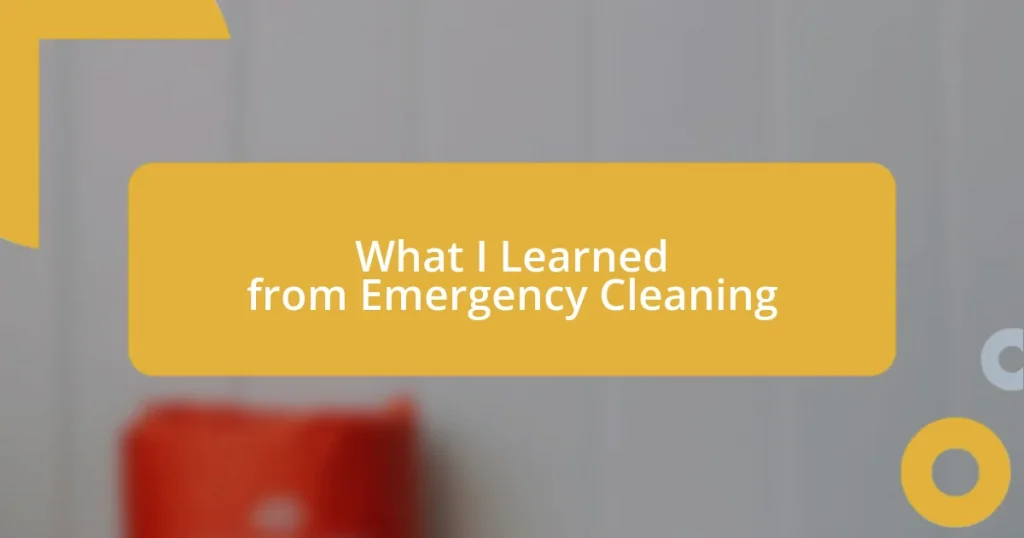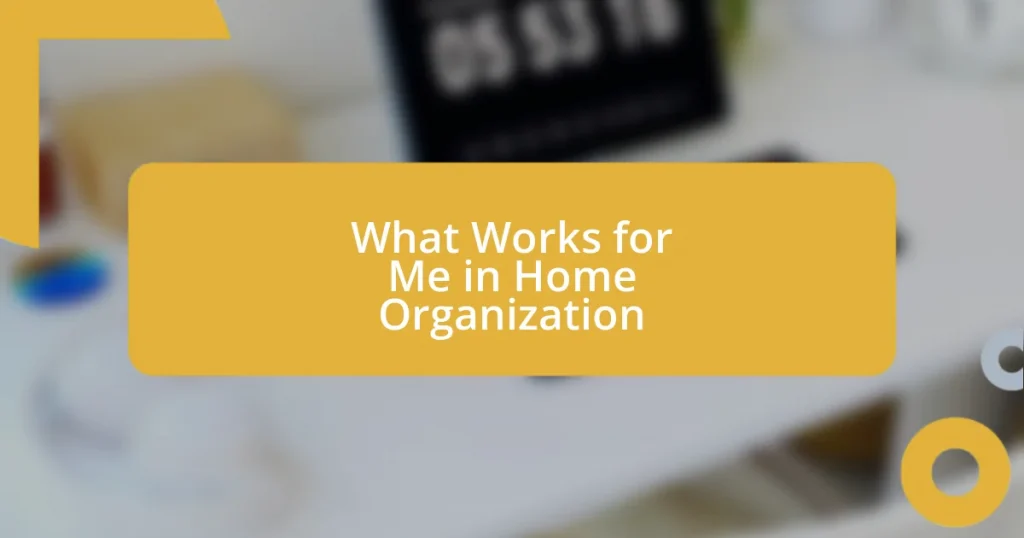Key takeaways:
- Effective preparation involves gathering documents, communicating with the team, and practicing potential questions to ensure confidence during the audit.
- Creating a transparent audit environment enhances collaboration, with tailored questioning and building trust leading to more insightful outcomes.
- Regular evaluations of the audit process foster continuous improvement, allowing teams to identify areas for growth and better alignment of expectations and capabilities.

Preparing for your first audit
Preparing for your first audit can feel daunting, but I remember the sense of anticipation that accompanied my initial experience. For me, it was crucial to start by gathering all relevant documents and data early on. Did I have everything? The fear of missing something was real, but having a clear checklist made me feel more in control and ready.
I learned quickly that communicating with my team before the audit was essential. I still recall one particularly tense morning when I realized I hadn’t briefed everyone on what to expect. That last-minute huddle calmed my nerves and set the stage for a cohesive approach. Have you ever found yourself wishing you’d communicated something sooner? Little moments like these can profoundly impact the entire audit experience.
As the date approached, I also found it vital to practice answers to potential questions. I vividly remember sitting with my notes, running through scenarios in my head. What would they ask about my financial reporting processes? This preparation not only helped to alleviate anxiety but also empowered me with confidence, making it easier to engage with the auditors. How would you prepare for tough questions if you were in my shoes? It’s when you envision those scenarios that the real learning begins.

Conducting a comprehensive audit
Conducting a thorough audit goes far beyond just collecting paperwork; it’s about creating an environment of transparency. I recall a time when my team and I sat together, pouring over financial statements, ensuring every fiber of our data was woven together cohesively. It felt like piecing together a puzzle where each detail mattered. Can you feel the excitement of discovering a missing piece? That’s the essence of a comprehensive audit.
As I delved deeper into the audit process, I discovered the importance of asking the right questions. I once approached an audit with a list of common inquiries but found that digging into deeper, more tailored questions revealed the heart of the matter. It’s almost like peeling back the layers of an onion; each layer unveils something new and necessary for clarity. Have you thought about how probing questions could shift perspectives during an audit?
Another critical aspect was fostering open lines of communication. There was a day during an audit when I managed to establish a rapport with the auditors, leading to a fruitful discussion that cleared up potential misunderstandings. That moment taught me that establishing trust can transform the auditing process from a mere obligation into a collaborative effort. Do you see how trust can influence your audit outcomes? Embracing these moments enriches the journey of an audit.
| Aspect | Traditional Approach | Comprehensive Approach |
|---|---|---|
| Document Collection | Gathering as needed | Proactively preparing all relevant data |
| Questioning | Generic inquiries | Specific, tailored questions |
| Communication | Minimal interaction | Building rapport and trust |

Analyzing audit results effectively
Analyzing audit results requires not just a mechanical review of numbers but an interpretative approach. After my first few audits, I realized how important it is to take a step back and view the results as a narrative rather than a mere summary. During one particular audit, I remember feeling overwhelmed by a barrage of data. However, once I started looking for patterns and correlations, the chaos transformed into a coherent story that revealed underlying trends. It’s incredible how uncovering the “why” behind the numbers can provide actionable insights.
When analyzing results, I often find it helpful to ask myself specific questions that guide me through the data. Here are some points to consider:
- What are the trends in the data over the last few audits?
- Are there any red flags or areas that consistently underperform?
- How do these results align with our established goals and objectives?
- What actionable steps can we take based on what the data reveals?
- Is there a way to involve the team in interpreting these results for broader perspective?
These questions not only help dissect the numbers but also draw my team into the conversation, ultimately fostering a collaborative environment where everyone can contribute their unique perspectives. Engaging in this way has expanded my understanding and transformed the analysis into a supportive learning experience that’s beneficial for all.

Implementing changes after an audit
Implementing changes after an audit can often feel like embarking on a new adventure. I remember a time when my team conducted an audit that highlighted inefficiencies in our reporting process. At the end of the audit, we were armed with actionable insights, which sparked a series of brainstorming sessions that evolved our reporting from a rudimentary task into a streamlined operation. Isn’t it fascinating how a single audit can ignite such transformative energy within a team?
Once the findings were laid out, we decided to implement a few key changes right away. I vividly recall the moment we adopted a new project management tool; it was like a breath of fresh air. Suddenly, tasks were tracked and organized in a way that alleviated confusion and boosted accountability. Have you ever experienced the joy of seeing a chaotic situation improve with a simple tool? It’s those little adjustments that can create monumental shifts in productivity.
As we moved forward, we kept the channels of communication wide open, encouraging team members to voice their concerns about the changes. During this phase, I discovered how vital it is to involve everyone in the process. One day, a team member brought up a potential issue with the new reporting structure, which led to us adjusting our approach. Engaging the team not only fostered ownership of the changes but also turned potential pitfalls into valuable learning opportunities. How could harnessing the collective knowledge within your team transform your post-audit implementation strategy?

Communicating findings with clients
Communicating findings with clients is an art in itself. I always strive for transparency in these discussions because honesty builds trust. A memorable experience was when I had to present a challenging audit outcome to a long-term client. My approach was to frame the conversation around solutions rather than problems, which led to a constructive dialogue. Have you ever thought about how the right approach can shift a client’s perspective from frustration to opportunity?
I usually start by summarizing the key takeaways succinctly, ensuring the client understands the implications without feeling overwhelmed. During one meeting, I used visual aids—charts and graphs—to help illustrate the trends we had discovered. The moment I noticed the client’s eyes light up as they grasped the data’s significance was unforgettable. This interaction made me realize how impactful visual storytelling can be in making complex findings accessible. Have you considered how effective visuals can transform client communication for your own audits?
After presenting the findings, I actively invite feedback and questions. This step is fundamental because it allows clients to voice their thoughts and concerns, fostering a collaborative atmosphere. I remember one instance where a client expressed skepticism about a particular recommendation. By engaging in an open discussion, we unraveled their concerns and adjusted the plan to better suit their needs. Isn’t it amazing how creating a dialogue around findings can turn what could be a contentious moment into a partnership opportunity?

Evaluating the audit process regularly
Evaluating the audit process regularly is crucial for continuous improvement. I remember when my team reviewed our auditing procedures after noticing inconsistencies in how our clients responded to findings. We brought everyone together, celebrated our successes, and identified areas needing attention, which not only strengthened our approach but also reinforced our commitment to excellence. Have you ever taken the time to reflect on your methods and realized how many opportunities for growth were just waiting to be uncovered?
Incorporating regular evaluations into our audit cycle proved transformative. I can recall a pivotal meeting where we dissected an audit that wasn’t well-received. By analyzing what went wrong, we pinpointed communication issues and adjusted our training programs accordingly. This process reminded me that evaluating the audit isn’t just about the numbers; it’s about understanding the human factors at play. Have you considered how the people behind the audit influence its success?
An ongoing assessment serves as a safety net that captures lessons learned along the way. For instance, during one evaluation, we discovered that our timeline estimations were consistently off, leading to rushed reports. By revisiting how we managed time during audits, we implemented new scheduling practices that aligned with the realities of our workflow. I realized how vital it is to align audit expectations with actual capabilities. Wouldn’t you agree that fine-tuning processes can lead to a much smoother experience for everyone involved?















